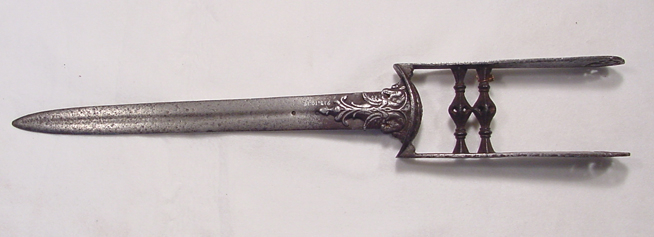Weapon Wednesday: The Indian Katar, a Necessary Dress Accessory

In South Asia during the 16th to early 20th centuries all fashionable young men when visiting their ladies would want to dress at their best. This would include one very necessary dress acessory: the katar. This uniquely South Asian dagger is thought to have developed in the very southern part of what is now India. In the 17th century the type was adopted across South Asia, and became a standard dress accessory in the Mughal courts.

Indian painting, 18th century (#924.12.145). Note the katar in the belt of the gentleman on the right as he approaches the two ladies while giving them "the smoulder."

Detail of Indian painting, 18th century (#973.150.2) this is actually a detail of about 2 cm high in the background of a painting.

Katar from 18th century India (#909.64.24). Note the elephant carved into the steel and then gilded.
The katar is also often referred to as a "punch-dagger" because of how it would have been used. The blades are of very high-quality steel, with edges as sharp as a razor, so it could also be used to slash an adversary, but it is most effective in the thrust. Examples in the ROM collection with elephants depicted on them probably are meant to be evocative of the thrust of the dagger. The blades are very sturdy for this reason. Depictions of slightly more heavily armed men would often show them armed with a katar and a sword, suggesting that the katar was also used as a left-hand weapon during sword-fighting. For this the side bar and the sturdy blade would have made the katar a very effective weapon for blocking a sword blow.

Katar from 18th century India (#907.15.24). Note the elephant carved into the steel.
In the 19th century the weaponsmiths of India made some very odd and impractical daggers for the European market, such as katars nesting inside hollow katars, scissor-like katars, and katars with flintlock guns on each side. In some of the older literature it is possible to see some writers talk about how this reflects what they called the "Oriental mind," so it is rather ironic to think that the South Asian smiths actually made them to appeal to the "Occidental" mind. It rather reminds one of Gandhi's response to a journalist asking him what he thought of Western civilsation. He said it would be a good idea.

Katar from southern India, 17th century (#966X163.9)
Further reading:
